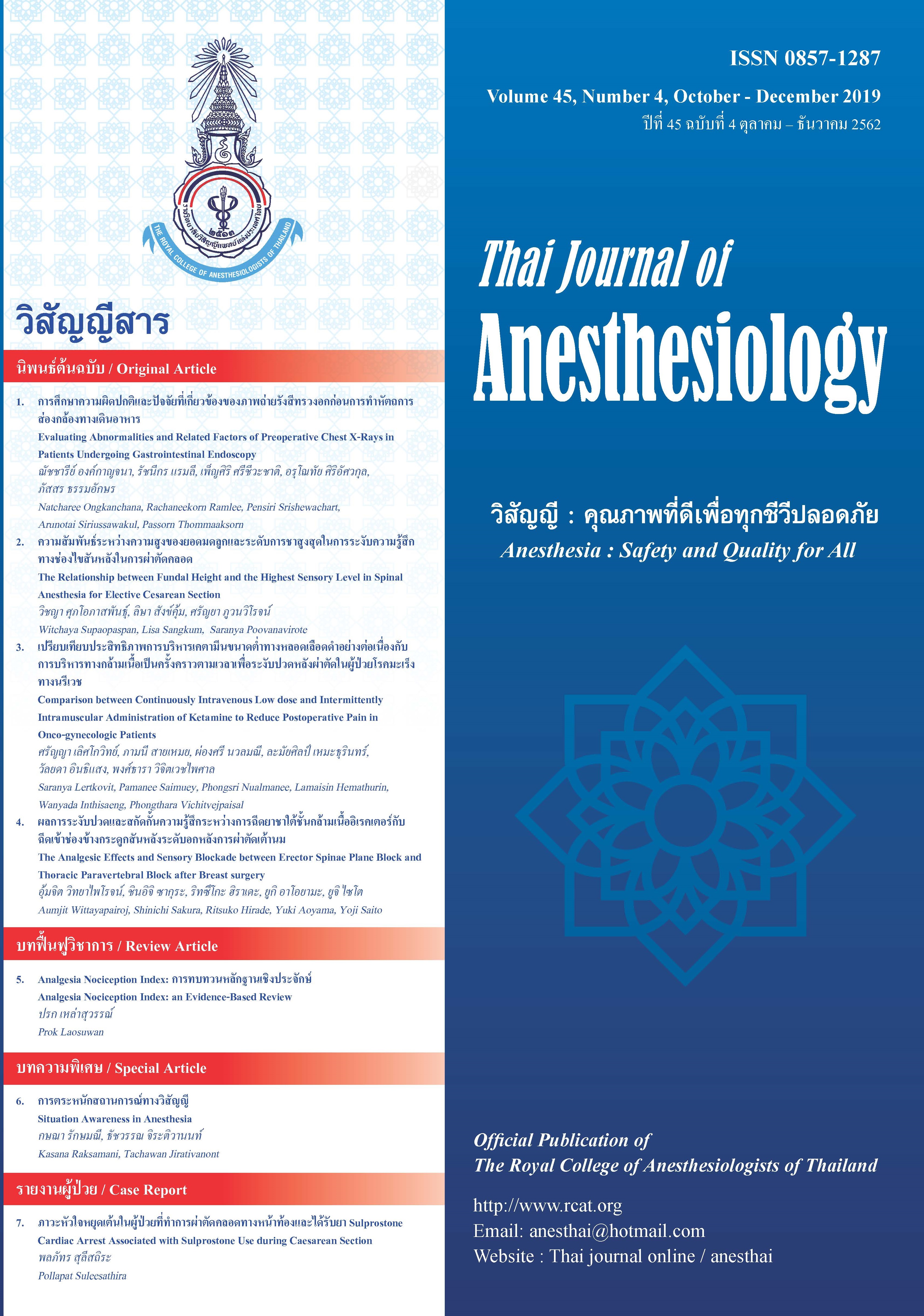Evaluating Abnormalities and Related Factors of Preoperative Chest X-Rays in Patients Undergoing Gastrointestinal Endoscopy
Main Article Content
Abstract
Background and objective: Preoperative Chest X-rays
(CXR) prior to intervention may be unnecessary among
patients with unremarkable history and physical
examination. Currently, there is no institutional guideline
of preoperative CXR for ambulatory procedure. This study
was designed to determine the proportion of abnormal
preoperative CXR in patients underwent gastrointestinal
endoscopy. Other objectives were to identify factors
associated with abnormalities and to describe the
intraprocedural complications.
Materials and Methods: The retrospective study was
conducted on adult patients underwent ambulatory
gastrointestinal endoscopy under sedation. The
abnormalities of pre-procedural CXR were classified into
cardiomegaly, active and inactive pulmonary infiltration,
lung nodule and bone abnormalities.
Results: Data of 580 patients were reviewed. The
proportion of abnormal CXR was 52.1%, predominantly
reported as cardiomegaly. The factors associated with
abnormalities were age (Adjusted OR 95% ,70.1 CI 1.05-
1.09), p< 0.001), American Society of Anesthesiologists
(ASA) classification II and III (Adjusted OR 1.68, 95%,
CI 1.09-2.59, p< 0.05) and Adjusted OR 6.40, 95%
CI 3.03-13.55, p< 0.001, respectively) The optimum cut-off
points of age, determined from the area under ROC curve
0.74 (95% CI 0.70-0.78), was ≥ 55 years old with 80.86%
sensitivity and 46.57% specificity. Intra-procedural
complications were 14.4% (hypotension (12.9%),
desaturation (0.5%), bradycardia, (0.7%) and hypertension
(0.3%)).
Conclusion: The proportion of abnormal preoperative
CXR was high and consistent with co-existing diseases
and aging. The age above 55 years might be an indicator
to detect CXR abnormalities among ambulatory patients.
Nevertheless, history taking and physical examination
were attributable for obtaining CXR while the procedure
under sedation by certified anesthesia personnel
demonstrated low rate of cardiorespiratory adverse events.
Article Details
References
Tonkovic D. Usefulness of routine chest X-ray in preoperative
evaluation of patients undergoing non-cardiopulmonary
surgery: a prospective observational study. Eur J
Anaesthesiol 2012;29:16.
2. Ali IS, Khan M, Khan MA. Routine preoperative chest x-ray
and its impact on decision making in patients undergoing
elective surgical procedures. J Ayub Med Coll Abbottabad
2013;25(1-2):23-5.
3. Munro J, Booth A, Nicholl J. Routine preoperative testing: a
systematic review of the evidence. Health Technol Assess
1997;1(12):1-62.
4. Perez A, Planell J, Bacardaz C, et al. Value of routine
preoperative tests: a multicentre study in four general
hospitals. BJA 1995;74:250-6.
5. Keshavan VH, Swamy CM. Preoperative laboratory testing:
A prospective study on comparison and cost analysis. Indian
J Anaesth 2016;60(11):56-60.
6. Joo HS, Wong J, Naik VN, Savoldelli GL. The value of
screening preoperative chest x-rays: a systematic review.
Can J Anaesth 2005;52:568-74.
Ramos LWF, Souza CF, Dias IWH, et al. Validity time of
normal results of preoperative tests for surgical reintervention
and the impact on postoperative outcomes. Rev Bras
Anestesiol 2018;68(2):154-61.
8. Apfelbaum JL, Connis RT, Nickinovich DG, et al. Practice
advisory for preanesthesia evaluation: an updated report by
the American Society of Anesthesiologists Task Force on
Preanesthesia Evaluation. Anesthesiology 2012;116:522-38.
9. The national institute for health and clinical excellence
(NICE). Preoperative tests- the use of routine preoperative
tests for elective surgery. London: National collaborating
center for acute care; 2003.
10. Kirkham KR, Wijeysundera DN, Pendrith C, et al. Preoperative
testing before low-risk surgical procedures. CMAJ 2015;
187(11):E349-58.
11. Dej-arkom S, Kiatchai T and Siriussawakul A. Prevalence
and Characteristics of Abnormal Pre-operative Chest X-rays
in Patient Undergoing Elective Surgery. J Med Assoc Thai
2016;99:491-6.
12. World Health Organization. Global tuberculosis report 2012
[Internet]. France: WHO; 2012 [cited 2013 Oct 21]. Available
from: http://apps.who.int/iris/bitstream/10665/75938/1/
9789241564502_eng.pdf
13. Brown SR, Brown J. Why do physicians order unnecessary
preoperative tests? A qualitative study. Fam Med 2011;43(5):
338-43.
14. Hochhegger B, Meirelles GS, Irion K, et al. The chest and
aging: radiological findings. J Bras Pneumol 2012;38(5):
656-65.
15. Sommerville TE, Murray WB. Information yield from routine
preoperative chest radiography and electrocardiography. S
Afr Med J 1992;81:190-6.

